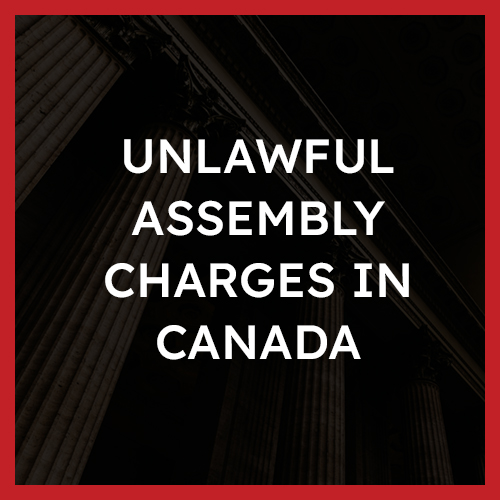Unlawful Assembly (s. 63) Laws in Canada
What is a unflawful assembly?

The offence of “Unlawful Assembly” is covered by Section 63 of the Criminal Code of Canada.
The offence of “Unlawful Assembly” prohibits the assembly of three or more persons who, with intent to carry out any common purpose, assemble in such a manner or so conduct themselves when they are assembled as to cause persons in the neighbourhood of the assembly to fear, on reasonable grounds, that they (a) will disturb the peace tumultuously; or (b) will by that assembly needlessly and without reasonable cause provoke other persons to disturb the peace tumultuously.
In other words, an assembly becomes unlawful those taking part, know that their conduct will cause others in the neighbourhood to fear on reasonable grounds that those participating to
- disturb the peace tumultuously; or
- needlessly and without reasonable cause provoke other persons to join them in their actions
Unlawful assembly offences are punishable as a summary offence.
The punishment for unlawful assembly is more serious if there there is an unlawful assembly “while wearing a mask or other disguise to conceal their identity”
Punishments for unlawful assembly offences are outlined in Section 66 of the Code.
When an unlawful assembly begins to disturb the peace tumultuously it is considered a riot outlined by Section 64 of the Code.
Examples
- Attending a party that quickly grows larger and spirals out of control.
- Participating in a protest while armed with rocks and protective gear.
Defences
- Protection under Sections 1 & 2 of the Canadian Charter of Rights and Freedoms.
Punishment
- Punishments for unlawful assembly offences are outlined in Section 66.
- Unlawful Assembly is a summary conviction offence.
- Section 66(1) of the Code outlines that the maximum penalty for the offence of unlawful assembly is a $5000 fine and/or a term of imprisonment not exceeding six months.
- Section 66(2) of the Code outlines that If the offence is committed “while wearing a mask or other disguise to conceal their identity” there is a maximum penalty of 5 years imprisonment.
- This offence has no mandatory minimum penalties.
Overview of the Offence
Section 63 of the Criminal Code of Canada states:
“63 (1) An unlawful assembly is an assembly of three or more persons who, with intent to carry out any common purpose, assemble in such a manner or so conduct themselves when they are assembled as to cause persons in the neighborhood of the assembly to fear, on reasonable grounds, that they
(a) will disturb the peace tumultuously; or
(b) will by that assembly needlessly and without reasonable cause provoke other persons to disturb the peace tumultuously.
(2) Persons who are lawfully assembled may become an unlawful assembly if they conduct themselves with a common purpose in a manner that would have made the assembly unlawful if they had assembled in that manner for that purpose.
(3) Persons are not unlawfully assembled by reason only that they are assembled to protect the dwelling-house of any one of them against persons who are threatening to break and enter it for the purpose of committing an indictable offence therein.”
Section 66 of the Criminal Code of Canada states:
Punishment for unlawful assembly:
66 (1) Every one who is a member of an unlawful assembly is guilty of an offence punishable on summary conviction.
Concealment of identity:
(2) Every person who commits an offence under subsection (1) while wearing a mask or other disguise to conceal their identity without lawful excuse is guilty of
(a) an indictable offence and liable to imprisonment for a term not exceeding five years; or
(b) an offence punishable on summary conviction.
Interpretation of the Offences
Unlawful Assembly is a specific intent offence. This means that the accused must be aware that the assembly was for the purpose of disturbing peace and that their conduct would cause reasonably-grounded neighbourhoods to fear that they will be disturbed tumultuously.
The term “tumultuously” requires ” some elements of violence or force which may be exhibited by menaces of threats”.– R. v. Berntt
Unlawful assembly is a general intent offence, which means it considers only the “intent to the commission of the act” – R . v. George
Defences
If charged with an offence relating to rioting, a common defence would be your protection under the Canadian Charter of Rights and Freedoms
Section 2 of The Canadian Charter of Rights and Freedoms guarantees freedom of conscience and the freedom of peaceful assembly.
Section 1 of the Canadian Charter of Rights and Freedoms is the section that confirms that the rights listed in the Charter are guaranteed. The section is also known as the reasonable limits clause or limitations clause, as it legally allows the government to limit an individual’s Charter rights.
At the Supreme Court of Canada in the case of Oakes , it was established that a limit on a Charter right must be “reasonable” and “demonstrably justified.”
The test for this threshold is also outlined in Oakes.
- There must be a pressing and substantial objective
- The means must be proportional
- The means must be rationally connected to the objective
- There must be minimal impairment of rights
- There must be proportionality between the infringement and objective
However, these rights are not without limits. The Supreme Court of Canada has recognized that freedom of expression does not extend to protect against threats of violence, acts of violence, the destruction of property or other unlawful conduct.
For example:
- Expression that takes the form of violence is not protected by the Charter – Irwin Toy Ltd
- Whether or not physical violence is expressive, it will not be protected by section 2(b) – v. Keegstra
- Threats of violence also fall outside the scope of section 2(b) protection- v. Khawaja
Punishments
| UNLAWFUL ASSEMBLY | ||
| Criminal Code of Canada Section | Summary of the Section/Offence | Punishment |
| Section 63 | Unlawful Assembly- prohibits an assembly becomes unlawful if those taking part, know that their conduct will cause others in the neighbourhood to fear on reasonable grounds that those participating to
1. disturb the peace tumultuously; or 2. needlessly and without reasonable cause provoke other persons to join them in their actions |
Punishment of Section 63 offences is governed by Section 66 of the Code. |
| Section 66(1) | Punishment of Section 63 offence of Unlawful Assembly is governed by Section 66(1) of the Code. | Punishable as a summary offence with a maximum penalty of $5000 and/or a term of imprisonment not exceeding six months.
This offence has no mandatory minimum penalties. |
| Section 66(2) | Unlawful Assembly “while wearing a mask or other disguise to conceal their identity” | Punishable as a summary offence with a maximum penalty of 5 years imprisonment.
This offence has no mandatory minimum penalties. |
Frequently Asked Questions
Is unlawful assembly the same as a riot?
An unlawful assembly is not the same as a riot. An unlawful assembly that has begun to disturb the peace tumultuously is considered a riot.
“Tumultuously” requires ” some elements of violence or force which may be exhibited by menaces of threats”.
What type of offence is unlawful assembly?
Unlawful Assembly is a summary offence.
Unlawful Assembly is also a specific intent offence. This means that the accused must be aware that the assembly was for the purpose of disturbing peace and that their conduct would cause a reasonably-grounded neighborhood to fear that they will be disturbed tumultuously.
When is an unlawful assembly considered a riot?
When an unlawful assembly begins to disturb the peace tumultuously it is considered a riot outlined by Section 64 of the Code.
Published Decisions
R. v. Conway, 2006 QCCS 1214
A number of Aboriginal defendants were found guilty of unlawful assembly after rioting erupted when the Band Council voted to replace the police service in their community with Mohawk police officers. The protests escalated to the point where the Native police officers were barricaded inside the police station. The defendants who were found guilty of forcible confinement and rioting were sentenced to imprisonment ranging from 3 to 15 months, depending on the severity of their criminal records.
However, the defendants that were only found guilty of unlawful assembly and had no criminal records were granted conditional discharges with a condition to make a charitable donation, while those with records were fined. The court commented on the less serious nature of the offence of unlawful assembly (at paras. 21-23):
“Unlawful assembly is a relatively minor crime, punishable on summary conviction. It is in the power of the Court to discharge the accused instead of convicting them if it considers it to be in the best interests of the accused and not contrary to the public interest. Suffice it to say, for the time being, that the Court would hesitate to burden someone with a criminal record for an offence of unlawful assembly unless they already had a criminal record.”
View the full decision here.
R. v. Rushton, 2007 BCPC 160
The defendant organized a party that quickly grew larger and spiralled out of control. Police arrived after neighbours complained and the confrontation escalated to the point where beer bottles and other objects were thrown at the police. The defendant pleaded guilty to unlawful assembly and received a suspended sentence and 18 months probation. The court noted in mitigation that Rushton wrote a letter of apology to his neighbours and he cleaned up and repaired damage to their property. He was also able to provide good employment references. The court indicated that absent these mitigating factors, he would be facing a term of imprisonment.
View the full decision here.
R. v. Avrett, 2001 BCPC 281
The defendants were environmental activists who were charged with intimidation by obstructing a highway, and obstruction of a peace officer. They created a barrier on an access bridge, camped out in trees refusing to come down and they dropped debris on police officers who attempted to remove them. The defendants had no criminal records and one day of pre-trial custody. Although they pleaded guilty, they expressed no remorse for their actions. Each accused received a suspended sentence and 12 months probation with community service.
View the full decision here.
About The Author







